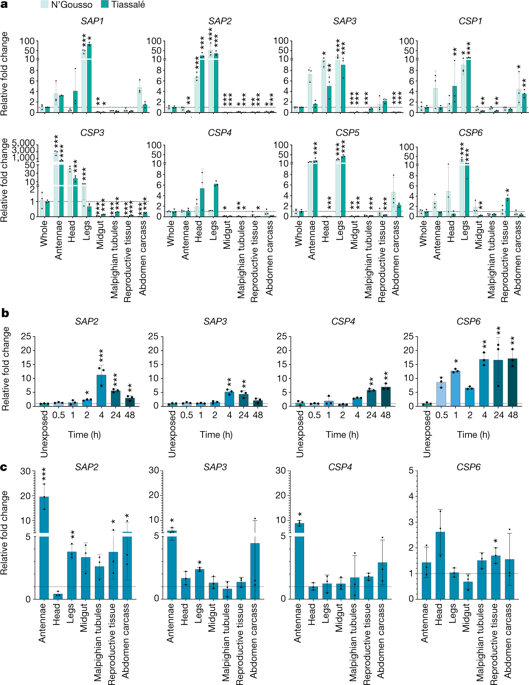Our official English website, www.x-mol.net, welcomes your
feedback! (Note: you will need to create a separate account there.)
A sensory appendage protein protects malaria vectors from pyrethroids
Nature ( IF 50.5 ) Pub Date : 2019-12-25 , DOI: 10.1038/s41586-019-1864-1 Victoria A Ingham 1 , Amalia Anthousi 1 , Vassilis Douris 2, 3 , Nicholas J Harding 4 , Gareth Lycett 1 , Marion Morris 1 , John Vontas 2, 5 , Hilary Ranson 1
Nature ( IF 50.5 ) Pub Date : 2019-12-25 , DOI: 10.1038/s41586-019-1864-1 Victoria A Ingham 1 , Amalia Anthousi 1 , Vassilis Douris 2, 3 , Nicholas J Harding 4 , Gareth Lycett 1 , Marion Morris 1 , John Vontas 2, 5 , Hilary Ranson 1
Affiliation

|
Pyrethroid-impregnated bed nets have driven considerable reductions in malaria-associated morbidity and mortality in Africa since the beginning of the century 1 . The intense selection pressure exerted by bed nets has precipitated widespread and escalating resistance to pyrethroids in African Anopheles populations, threatening to reverse the gains that been made by malaria control 2 . Here we show that expression of a sensory appendage protein (SAP2), which is enriched in the legs, confers pyrethroid resistance to Anopheles gambiae . Expression of SAP2 is increased in insecticide-resistant populations and is further induced after the mosquito comes into contact with pyrethroids. SAP2 silencing fully restores mortality of the mosquitoes, whereas SAP2 overexpression results in increased resistance, probably owing to high-affinity binding of SAP2 to pyrethroid insecticides. Mining of genome sequence data reveals a selective sweep near the SAP2 locus in the mosquito populations of three West African countries (Cameroon, Guinea and Burkina Faso) with the observed increase in haplotype-associated single-nucleotide polymorphisms mirroring the increasing resistance of mosquitoes to pyrethroids reported in Burkina Faso. Our study identifies a previously undescribed mechanism of insecticide resistance that is likely to be highly relevant to malaria control efforts. The leg-enriched sensory appendage protein, SAP2, confers pyrethroid resistance to Anopheles gambiae , through high-affinity binding of pyrethroid insecticides; an observed selective sweep in field mosquitoes mirrors the increasing resistance reported in Africa.
中文翻译:

感觉附属蛋白可保护疟疾媒介免受拟除虫菊酯的侵害
自本世纪初以来,含有拟除虫菊酯的蚊帐已大大降低了非洲与疟疾相关的发病率和死亡率 1 。蚊帐施加的强烈选择压力导致非洲按蚊种群对拟除虫菊酯产生了广泛且不断升级的耐药性,有可能逆转疟疾控制所取得的成果 2 。在这里,我们表明,腿部富集的感觉附属蛋白(SAP2)的表达赋予冈比亚按蚊拟除虫菊酯抗性。 SAP2 的表达在对杀虫剂具有抗性的群体中增加,并且在蚊子接触拟除虫菊酯后进一步被诱导。 SAP2 沉默可完全恢复蚊子的死亡率,而 SAP2 过表达会导致抗药性增加,这可能是由于 SAP2 与拟除虫菊酯杀虫剂的高亲和力结合所致。基因组序列数据挖掘揭示了三个西非国家(喀麦隆、几内亚和布基纳法索)蚊子种群中 SAP2 基因座附近的选择性扫描,观察到单倍型相关单核苷酸多态性的增加,反映了蚊子对拟除虫菊酯的抵抗力增强布基纳法索报道。我们的研究确定了一种先前未描述的杀虫剂抗性机制,该机制可能与疟疾控制工作高度相关。腿部富含的感觉附属蛋白 SAP2 通过与拟除虫菊酯杀虫剂的高亲和力结合,赋予冈比亚按蚊对拟除虫菊酯的抗性;观察到的对野外蚊子的选择性清扫反映了非洲报告的抵抗力不断增强的情况。
更新日期:2019-12-25
中文翻译:

感觉附属蛋白可保护疟疾媒介免受拟除虫菊酯的侵害
自本世纪初以来,含有拟除虫菊酯的蚊帐已大大降低了非洲与疟疾相关的发病率和死亡率 1 。蚊帐施加的强烈选择压力导致非洲按蚊种群对拟除虫菊酯产生了广泛且不断升级的耐药性,有可能逆转疟疾控制所取得的成果 2 。在这里,我们表明,腿部富集的感觉附属蛋白(SAP2)的表达赋予冈比亚按蚊拟除虫菊酯抗性。 SAP2 的表达在对杀虫剂具有抗性的群体中增加,并且在蚊子接触拟除虫菊酯后进一步被诱导。 SAP2 沉默可完全恢复蚊子的死亡率,而 SAP2 过表达会导致抗药性增加,这可能是由于 SAP2 与拟除虫菊酯杀虫剂的高亲和力结合所致。基因组序列数据挖掘揭示了三个西非国家(喀麦隆、几内亚和布基纳法索)蚊子种群中 SAP2 基因座附近的选择性扫描,观察到单倍型相关单核苷酸多态性的增加,反映了蚊子对拟除虫菊酯的抵抗力增强布基纳法索报道。我们的研究确定了一种先前未描述的杀虫剂抗性机制,该机制可能与疟疾控制工作高度相关。腿部富含的感觉附属蛋白 SAP2 通过与拟除虫菊酯杀虫剂的高亲和力结合,赋予冈比亚按蚊对拟除虫菊酯的抗性;观察到的对野外蚊子的选择性清扫反映了非洲报告的抵抗力不断增强的情况。











































 京公网安备 11010802027423号
京公网安备 11010802027423号